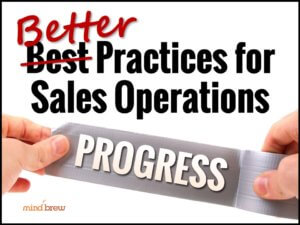Every society has its own unwritten rules that people generally follow without speaking about them. For example, in the US, there’s an unspoken rule that when you get in an elevator, you should turn around and face the door while the elevator is going up. If you’re attending an American wedding, you shouldn’t wear white unless you’re the bride. If you’re driving in a car and you pass a field of cows, someone in the car has to say, “Cows.”
Other cultures have unwritten rules of their own. In France, you should arrive to social events a little late. In China, you should not cross your legs while sitting down. In India, you should stand as close as possible to the person in front of you in line, but in Sweden, you should leave several feet of space.
As its own unique subculture, Sales Ops has some unwritten rules as well. Here are a few we highly recommend following:
- Don’t Just Give Management What They Ask For. Sometimes Sales Ops gets overly focused on reporting on what has happened. After all, it’s what management expects from the team. But all that data that the Sales Ops team is sitting on can also reveal improvements and optimizations that can be made to boost sales results the bottom line. This mindset lets you put your data analysis expertise to use in new ways, and can do wonders for your career path too. We cover this idea in greater detail in Delivering Data to Decision-Makers and How to Use Sales Analysis to Drive More Growth.
- You Need to Make Space for Strategy. For Sales Ops, it’s very easy to get mired in a tactical mindset. After all, that’s the role that so many in the organization expect Sales Ops to take. Plus, you have so many daily tasks thrown your way that you probably barely have time for lunch, let alone big picture thinking. The net result is that strategic work always gets put off until next week, next month, next quarter, next year. To counter that tendency, you need to make a plan and carve out the time to become more strategic. It won’t happen on its own. Learn how in From Tactical to Strategic Sales Ops
- Remember the Best Solution Is the One You Can Actually Accomplish. Of course a “best practice” would be ideal, but oftentimes, reaching that ideal requires far too much change and internal effort. If something isn’t achievable, it isn’t really “best” for your situation. Instead, aim for what you can realistically accomplish within the constraints that you have. Remember that minor improvements can be meaningful. By identifying specific small but powerful improvements to sales processes, the Sales Ops team can deliver impressive results. Check out ‘Better’ Practices for Sales Operations to learn more.
- Start Small. The effort and risk for a new sales initiative can feel daunting. What if it doesn’t work? What if you can’t get others on-board? The secret weapon that successful teams have discovered is to start small and prove things out. A wholesale change can require monumental effort, expense, and risk. But a pilot program allows you to make progress while also providing the space to make mistakes, test concepts, and figure out what works best. Successful Sales Ops Pilot Programs explains how to get started.
- Find the Root Causes.Sales Ops is rarely to blame for sales problems. But that doesn’t stop anyone from pointing their finger when things go wrong. In reality, problems that others find are often a symptom of larger issues. If you want to protect the business and your group’s reputation, you’re going to have to find — and fix — the true root causes. We cover how to do that in Diagnosing Sales Problems.
These unwritten Sales Ops rules haven’t caught on quite as much as some of the unwritten cultural rules we mentioned — especially that cows thing. But these have far bigger consequences in the long run.

















